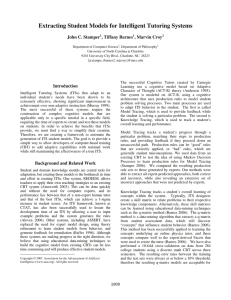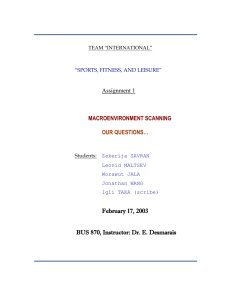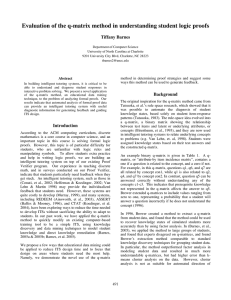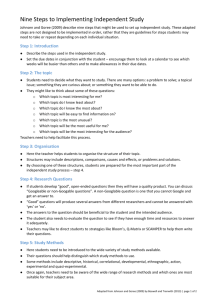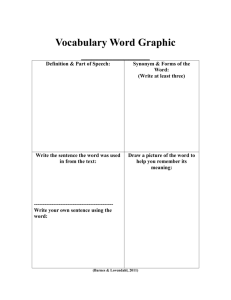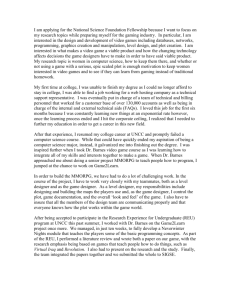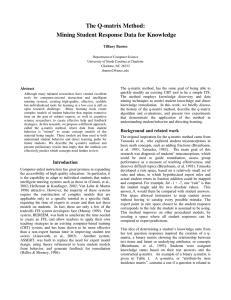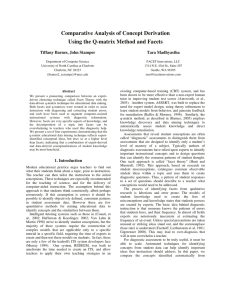pptx
advertisement
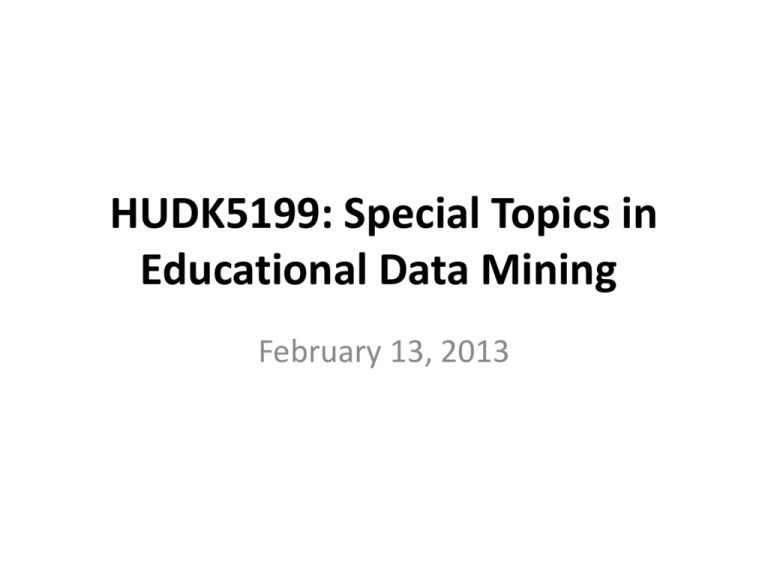
HUDK5199: Special Topics in
Educational Data Mining
February 13, 2013
Special Session on Excel
• We couldn’t find a time that worked for a majority of
you guys and worked for me
• So instead, we will start using the time between
4:40pm-5pm to go through Excel, RapidMiner, etc., tips
and methods
– Starting next class
– I will also try to cover more of this in class (I started last
time)
• We’ll end promptly at 5pm, since I know some of you
have 5:10pm classes
Today’s Class
• Knowledge Structure
Q-Matrix
(Tatsuoka, 1983; Barnes, 2005)
Skill1
Skill2
Skill3
Skill4
Item1
1
0
0
0
Item2
1
1
0
0
Item3
1
0
1
0
Item4
0
0
0
1
Item5
0
0
1
1
Item6
0
1
0
0
Example
Add
Subtract
Multiply
Divide
7+3+2
1
0
0
0
7+3-2
1
1
0
0
(7 + 3) * 2
1
0
1
0
7/3/2
0
0
0
1
7*3/2
0
0
1
1
7-3-2
0
1
0
0
How do we create a Q-Matrix?
• Hand-development and refinement
– Learning curves, as discussed by John
• Automatic model discovery
– Barnes’s approach; other approaches
• Hybrid approaches
– LFA, as discussed by John
Examples from Homework
• Let’s look at some examples of how you did
this in the homework
• After that, I will go over Barnes’s Q-Matrix
discovery algorithm in more detail
• As well as more complex models of domain
knowledge structure
Solutions
• Factor Analysis (most common solution) –
Huacheng Li, Diego Luna Bazaldua
• Correlation Matrix to Q-Matrix – Madeline
Weiss
• Fitting Q-Matrix – Cameron White
“True” Q-Matrix
(It is Simulated Data)
1
2
3
4
1
1
0
0
0
2
0
1
0
0
3
0
0
1
0
4
0
0
0
1
5
1
0
1
0
6
0
1
0
1
7
0
0
1
0
8
0
0
1
0
Perfect match to
Madeline & Huacheng
1
2
3
4
1
1
0
0
0
2
0
1
0
0
3
0
0
1
0
4
0
0
0
1
5
1
0
1
0
6
0
1
0
1
7
0
0
1
0
8
0
0
1
0
Hand Development and Refinement
• John Stamper showed examples of how
learning curves and other DataShop tools can
be used to do hand development and
refinement of knowledge structures
Hybrid Approaches
• John Stamper discussed the LFA algorithm in
class
Automated Model Discovery
• Let’s go through Barnes, Bitzer, & Vouk’s
(2005) pseudocode for fitting a Q-Matrix
Step 1
• Create an item/skill matrix
• How many skills should we use?
(In the algorithm, you repeat for 1 skill, 2 skills,
etc., until N+1 skills does not lead to a better
model than N skills)
Step 2: Follow pseudocode
Q-Matrices
• Questions? Comments?
Q-Matrix Discovery
• Let’s fit a Q-Matrix
• For Feb. 13 class data set
• Using algorithm from Barnes, Bitzer, & Vouk
More complex approaches
• Other Q-matrix approaches
– Non-negative matrix factorization
• Other knowledge structures
– Partial Order Knowledge Structures
– Bayesian Networks
Non-negative matrix factorization
(Desmarais et al., 2012)
• Approach similar to principal component
analysis or factor analysis
• Reduces dimensionality of data by finding
groups of items associated with each other
• Involves Linear Algebra; we won’t go into the
mathematics today
Partial Order Knowledge Structures
(Desmarais et al., 1996, 2006)
• Postulate relationships between items
• Mastery of one item
is prerequisite to
mastery of another item
Example
(Desmarais et al., 2006)
B does not inform us
about C
If student succeeds at C,
they will succeed at D;
D is prerequisite to C
Extension to skills
• POKS can be extended rather easily to use
skills (interchangeable items) rather than
items
Bayesian Networks
• Less restricted set of models that also infer relationships
between skills and items, and between skills
• Can infer more complicated relationships between material
than the very restricted set of relationships modeled in
POKS
– Can infer {skill-skill, item-item, skill-item} relationships at the
same time
– Can integrate very diverse types of information
• That extra flexibility can lead to over-fitting (cf. Desmarais
et al., 2006)
Martin & VanLehn (1995)
Conati et al., 2009
Shute et al., 2009
Next Class
• Wednesday, February 20
• Classification Algorithms
• Witten, I.H., Frank, E. (2011) Data Mining:
Practical Machine Learning Tools and
Techniques. Ch. 4.7, 6.1, 6.2, 6.5, 6.7
• Assignments Due: None
The End
